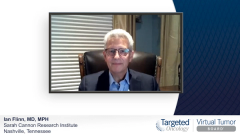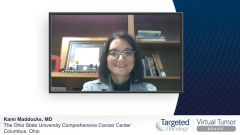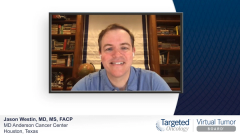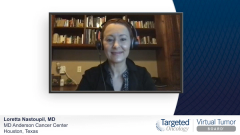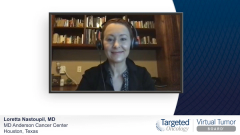
Case 2: Considerations for Choosing a Second-Line Therapy for DLBCL
Kami Maddocks, MD: In your practice what are you seeing as the most common reason for patients not receiving a transplant? It was mentioned if a patient refractory, had chemotherapy, you’re not really going to want to consider them for salvage chemotherapy and a transplant, regardless of age or eligibility. But what things are you guys most commonly seeing as reasons that patients—either not eligible or do not get transplant?
Ian Flinn, MD, MPH: Probably the number one reason is lack of chemosensitivity of their disease is the number one reason. But if you get beyond that, it’s more of a physiological issue in terms of do they have good heart function, do they have good pulmonary function? For most people that if they have chemosensitive disease and they otherwise physiologically are capable of undergoing the transplant, I think most of, at least our patients, would be willing to have the transplant. It seems to me it comes down to would most patients rather than not if it’s a potentially curative option for that patient.
Again, back to some of the organ function part in pulmonary and renal are the number one reasons for ineligibility in our center once you get beyond the chemotherapy sensitivity issue.
Kami Maddocks, MD: It’s probably rare that once you educate them well, you know, they’re going to decline a transplant if they’re really eligible and get a good response to salvage. That’s probably less likely to use them than not, not getting a transplant.
We’ve discussed this, although not maybe in great detail, but we know patients that are not candidates for transplant are still eligible, or maybe a candidate for CAR T. What are the differences in these patients, or what may make somebody ineligible for auto besides the progression but able to be treated with CAR [chimeric antigen receptor] T.
Loretta Nastoupil, MD: We’ve struggled with identifying clear criteria that select out CAR T patients. We know it’s not the same criteria that we often apply for auto-transplant. Though in my general practice if I have a patient who has measurable disease, I know there’s some data that you could proceed in the setting of CR [complete response]. But you probably need some antigen for those T cells to be, or CAR, to be worthwhile and to be effective. Having some measure of disease, and being able to withstand the acute toxicity, cytokine release syndrome, and neurotoxicity. It’s a little bit of in the eye of the beholder currently, but I there should be some reasonable performance status, some reasonable controlled comorbidities. We don’t take patients with active infection. There are some other sort of nuances in terms of pleural effusion and acute thrombosis. Though again we have some small numbers that suggest that those may not be that strong of a predictor of toxicity. It remains to be defined— who is an optimal candidate for CAR? If I have a patient with active disease and is going to tolerate the acute toxicity, I consider it in those patients.
Jason Westin, MD, MS, FACP: Agreed. And the take-home point from today’s session should be, it’s difficult for a physician who doesn’t do this for a living, doesn’t see patients and decide CAR T cell or not to make that determination. If you think there’s a potential this patient could have a curative option, refer them to a CAR T-cell center to have somebody who does CAR T cells all the time to help make that decision, because it is a bit of an eye-of-the-beholder thing. There’s not really clearly defined criteria either.
One thing that Dr Nastoupil mentioned about needing some antigen, needing to have a measurable tumor. We did publish a small series of patients that we treated on the JULIET study [NCT02445248] that had a complete response to bridging therapy that went on to subsequently get CAR T cells, not waiting for a relapse, and they had outcomes that were similar to other patients on the JULIET study. One of my patients is now 3 or 4 years out and is too healthy to come back to see me. She had a transient response to hyper-Cytoxan [CVAD (cyclophosphamide, vincristine sulfate, doxorubicin hydrochloride (Adriamycin), dexamethasone)]. I guess I shouldn’t say transient. She got hyper-Cytoxan and then went on to get tisagenlecleucel on that study, and never relapsed. And obviously hyper-Cytoxan is not going to give you 3 years of response. Everything else was said, I completely agree with it. It’s referred to a CAR T-cell center to decide who’s eligible for these advanced therapies.
Kami Maddocks, MD: What are treatment options for patients who don’t want or can’t repeat CAR T? I guess the other thing would be even in a patient who can receive CAR T, this patient is going to need some sort of therapy regardless if eventually it’s decided that they would be a candidate I know was mentioned—polatuzumab. Are there other options in this setting or what’s your approach to these patients?
Ian Flinn, MD, MPH: There’s a lot of heterogeneity about what is the best approach here. I don’t think we know what the best approach is. There are upsides and downsides of pretty much any therapy you might choose. For instance, if you were to get away from chemotherapy regimens for patients because, chemotherapy are refractory to begin with, then our options are things such as tafasitamab and lenalidomide. The problem with tafasitamab is that it’s a CD19-targeting agent. I don’t know that we have any data but we certainly worry about using a CD19-targeted therapy if you’re going to try to get them to CAR T cells. If you’re going to take a patient to a CAR T-cell therapy, then I think the options are much broader. Of course, the tafasitamab and lenalidomide, polatuzumab and bendamustine—rituximab, the new agents like selinexor that have been approved. I don’t know that anybody has, there’s any 1 answer for a given patient, and sometimes you’re going to go to more than 1 agent, or one therapy for a given patient.
Kami Maddocks, MD: Probably in this setting you’ll end up going through a number of therapies where, again, the patient unfortunately.
Transcript edited for clarity.



